Mg II solar activity index
The emission core of the Mg II doublet (280 nm) exhibits the largest natural solar irradiance variability above 240 nm. The core-to-wing ratio derived from the Mg II doublet is frequently used as a proxy for spectral solar irradiance variability from the UV to EUV associated with the 11-yr solar cycle (22-yr magnetic cycle) and solar rotation (27d). We derive Mg II data from GOME (1995-2011), SCIAMACHY (2002-2012), GOME-2A (2007-2020), GOME-2B (since 2012), and GOME-2C (since 2019).
All data sets as well as the Bremen Mg II composite data are available (see links below). The most recent information on our Mg II data can be found in Snow et al. (2014).
Data download
- Composite Mg II Index (1978-present) daily updated!
- Extended Mg II Index (1947-present) daily updated! new!
- GOME
Mg II Index (1996-2011)
- SCIAMACHY
Mg II Index (2002-2012)
- GOME-2A
Mg II Index
(2007-2020)
- GOME-2B
Mg II Index (since 2012) daily
updated!
- GOME-2C
Mg II Index (since 2019) daily
updated!
- F10.7cm solar radio flux
(since
1947, source) daily
updated!
- Japanese (e.g. F30cm) solar radio flux (since 1951, source) daily updated!
Visualisation of the Mg II indices
Figure 1 shows the Mg II data from GOME-2B (since 2012) and GOME-2C (since 2019) during the last two months.
Figure 2 shows the Mg II indices derived from GOME (1996-2011), SCIAMACHY (2002-2012), and three GOME-2 (since 2007) as calculated by us.
By combining data from different satellites a composite Mg II index can be derived that covers more than four solar cycles as shown in Figure 3.
In Figure 4 the solar activity from the five most recent solar cycles (21-25) are directly compared.
Figure 5 depicts the extended composite MgII index timeseries. F30cm and F10.7cm radio flux data have been used to extend the Mg II index back to year 1947.
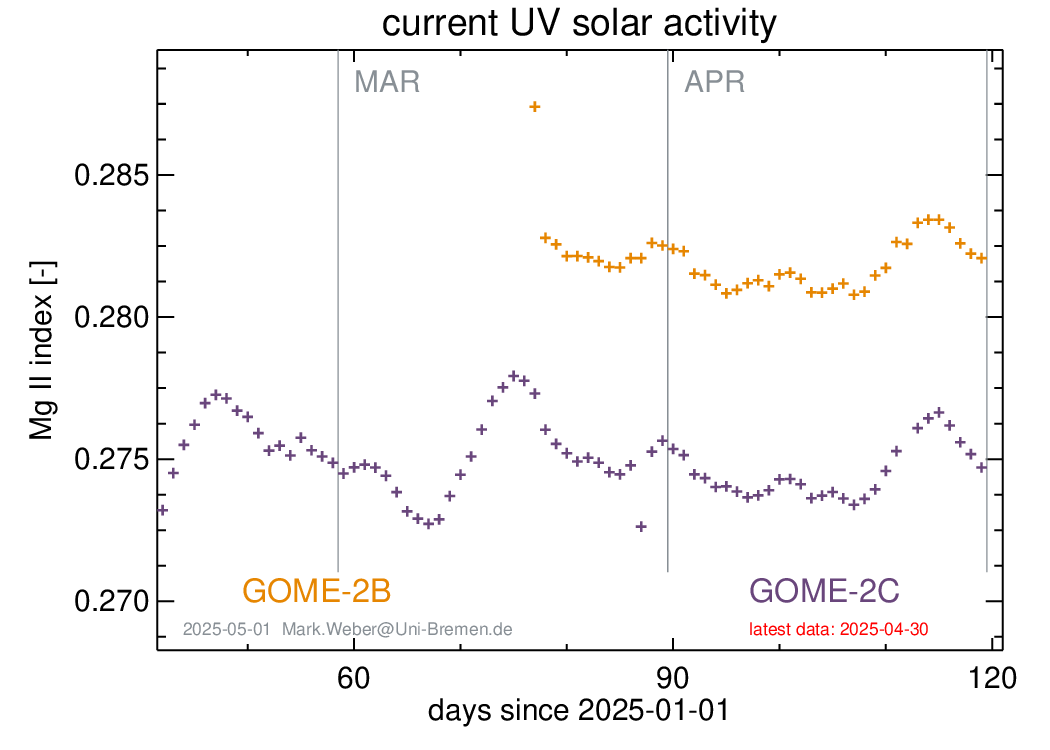
Figure 1. Mg II core-to-wing ratios from GOME-2B and GOME-2C during the last two months.
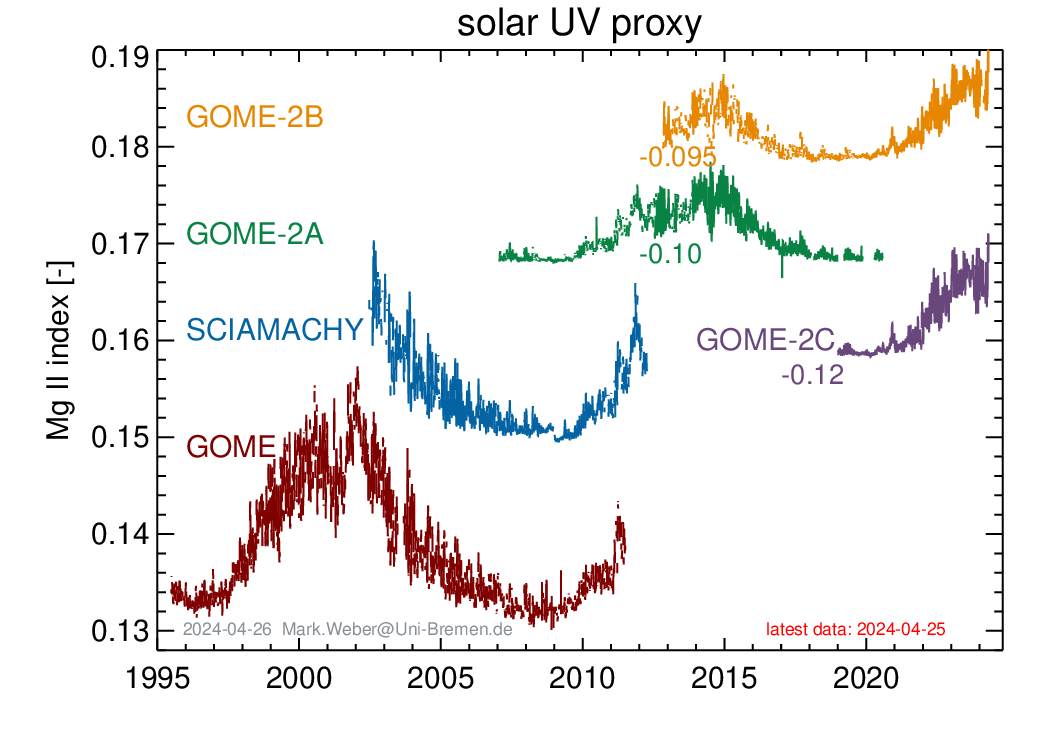
Figure 2. Mg II core-to-wing ratio from GOME, SCIAMACHY, GOME-2A, -2B, and -2C.
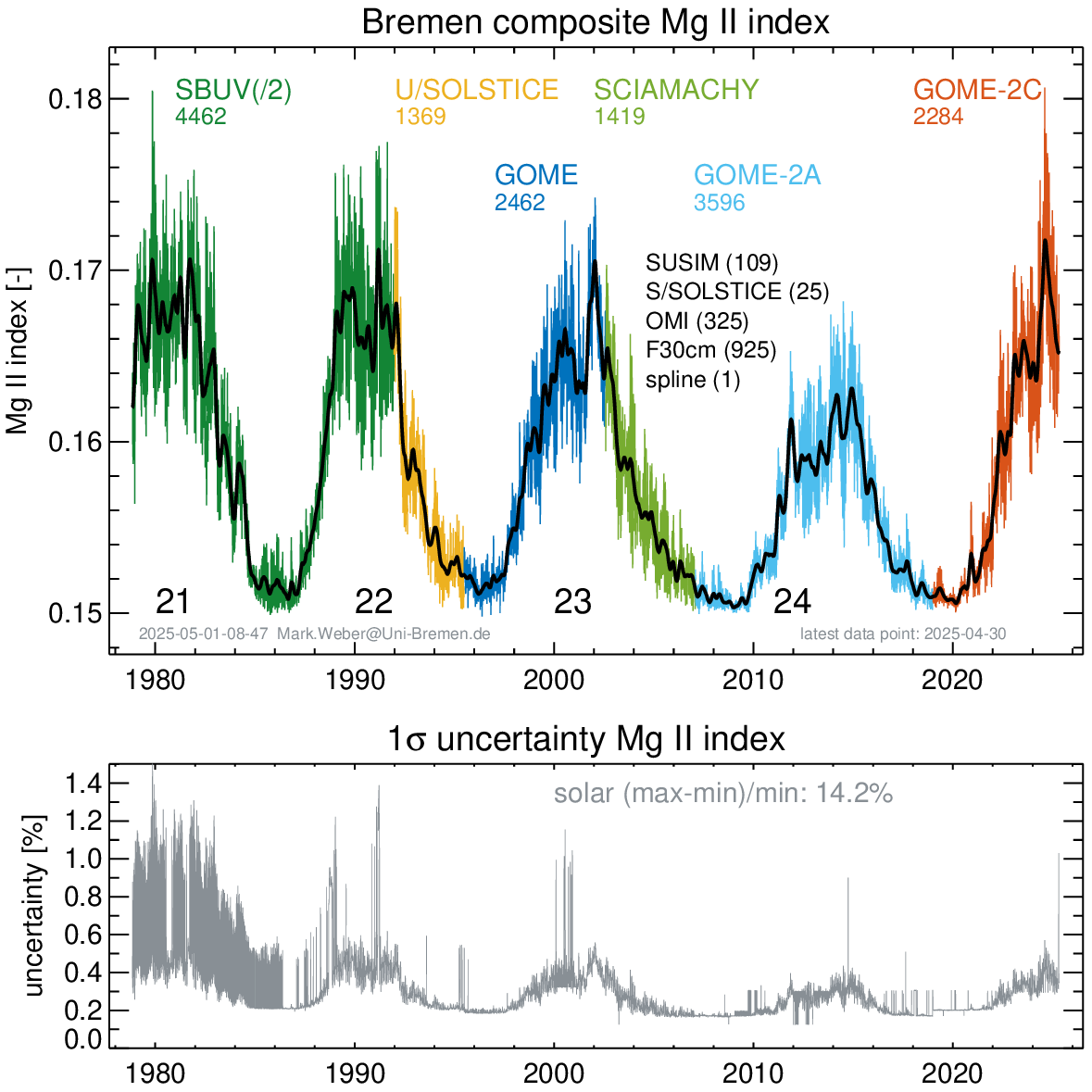
Figure 3. Composite Mg II index ('Bremen composite'). Values indicated are the numbers of days for each satellite contributing to the composite index. Missing values were filled using scaled F30 cm radio flux data (http://solar.nro.nao.ac.jp/norp/html/daily_flux.html). The black curve shows the timeseries twice smoothed with a 55-day boxcar. Bottom panel shows the estimated uncertainty of the composite Mg II index. Higher uncertainties are due to the interpolated F30cm values. The solar minimum to maximum change in this Mg II index is about 14% of the long-term mean of the smoothed Mg II time series. This means that the uncertainty of the Mg II index with respect to a typical solar cycle change is about 2% and higher.
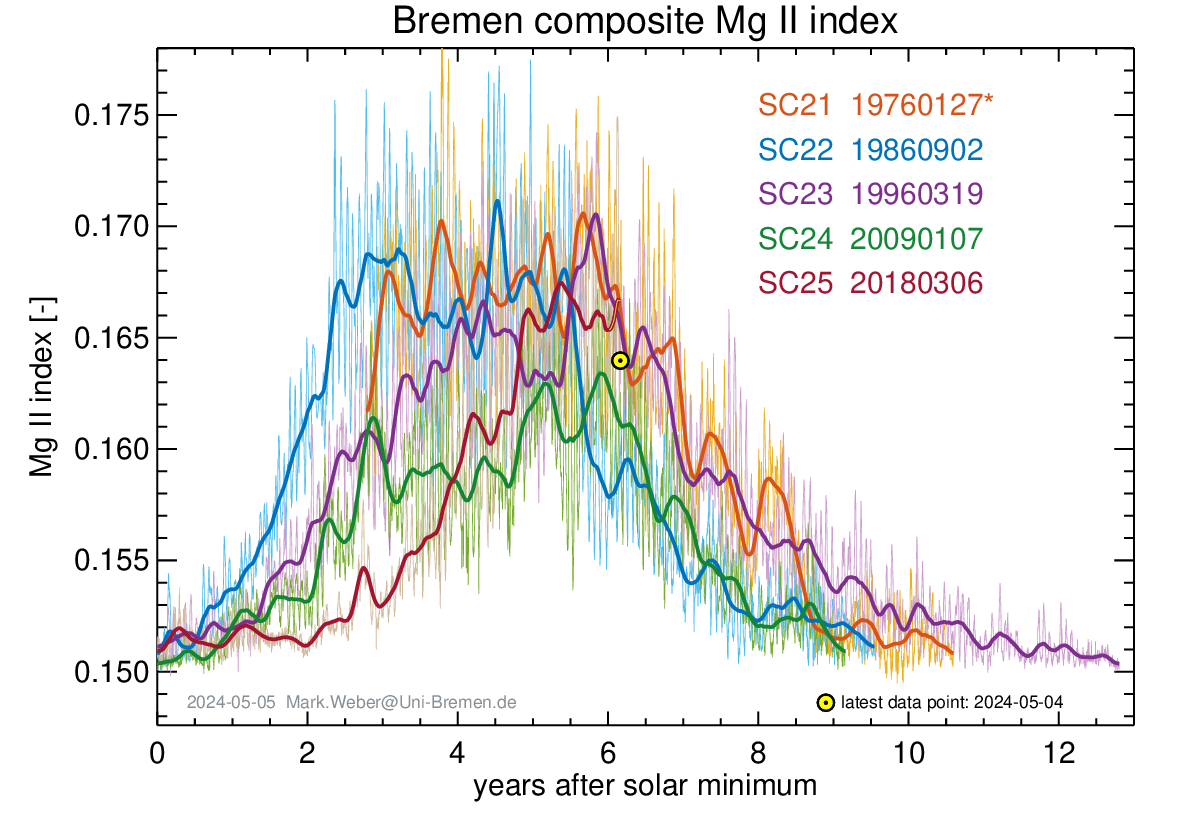
Figure 4. Comparison of UV solar activity during the last five recent solar cycles (SC) numbered 21-25. The thick curves show the Mg II index timeseries twice smoothed with a 55-day boxcar. Dates of minima of solar cycles (YYYYMMDD) were determined from the smoothed Mg II index. The minimum of SC 21 (about three years before the start of the Mg II index) was estimated to have occurred on January 26, 1976 as derived from the minimum of the sunspot number time series smoothed the same way as the Mg II index.
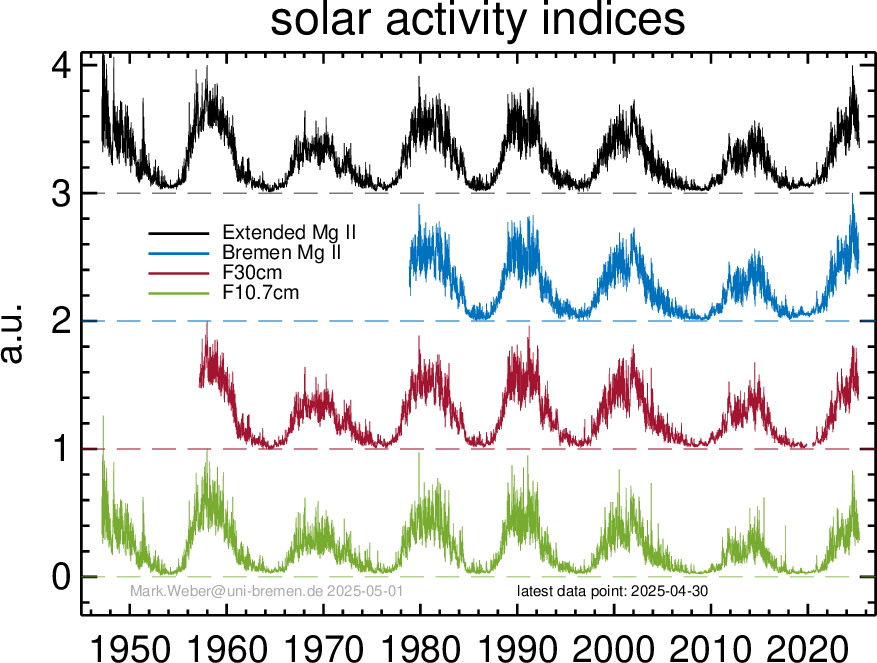
Figure 5. Extended Mg II index. Using F30cm and F10.7cm radio flux timeseries the Mg II index has been extended back to 1947. The radio flux data have been fitted linearly to the Mg II index and the data successiveley extended and gap filled (first F30cm radio flux, then F10.7cm flux).
References
Cebula, R.P., and M.T. DeLand, 1998: Comparisons of the NOAA11 SBUV/2, UARS SOLSTICE, and UARS SUSIM MgII solar activity proxy indices, Sol. Phys. 177, 117-132
DeLand, M.T., and R. P. Cebula, 1998: Solar UV activity at solar cycle 21 and 22 minimum from NOAA 9 SBUV2 data, Sol. Phys. 177, 105-116.
DeLand, M.T., and R. P. Cebula, 1993: Composite MgII solar activity index for solar cycles 21 and 22, J. Geophys. Res. 98, 12809-12823.
DeLand, M., and S. Marchenko, 2013: The solar chromospheric Ca and Mg indices from Aura OMI, J. Geophys. Res. Atmos., 118, 3415-3423, doi:10.1002/jgrd.50310.
de Toma, G., et al., 1997: Mg II core-to-wing index: Comparison of SBUV and SOLSTICE time series, J. Geophys. Res. 102, 2597-2610.
Floyd, L.E., et al., 1998: Solar cycle 22 UV spectral irradiance variability, Sol. Phys. 177, 79-87.
Snow, M., McClintock, W., Woods, T., White, O., Harder, J., and Rottman, G., The Mg II Index from SORCE, Solar Physics, 230, 325-344, 2005.
Snow, M., M. Weber, J. Machol, R. Viereck, and E. Richard, Comparison of Magnesium II core-to-wing ratio observations during solar minimum 23/24, J. Space Weather Space Clim., 4, A04, doi:10.1051/swsc/2014001, 2014.
Viereck, R.A., and L.C. Puga, 1999: The NOAA Mg II core-to-wing solar index: Construction of a 20-year time series of chromospheric variability from multiple satellites, J. Geophys. Res. 104, 9995-10005.
Viereck, R., L. Puga, D. McMullin, D. Judge, M. Weber, W.K. Tobiska, The Mg II Index: A Proxy for Solar EUV,Geophys. Res. Lett. 28, 1343-1346, 2001.
Viereck, R. A., L. E. Floyd, P. C. Crane, T. N. Woods, B. G. Knapp, G. Rottman, M. Weber, L. C. Puga, and M. T. DeLand, A composite Mg II index spanning from 1978 to 2003, Space Weather, 2, S10005, doi:10.1029/2004SW000084, 2004.
Weber, M., J.P. Burrows, and R.P. Cebula, 1998: GOME Solar UV/VIS Irradiance Measurements between 1995 and 1997 - First Results on Proxy Solar Activity Studies, Sol. Phys. 177, 63-77.
Weber, M., 1999: Solar activity during solar cycle 23 monitored by GOME, Proc. European Symposium on Atmospheric Measurements from Space (ESAMS'99), ESTEC, Noordwijk, The Netherlands, 18-22 January 1999, WPP-161, European Space Agency, p. 611-616, doi:10.26092/elib/501.

